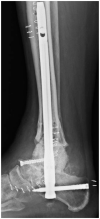Republication of "Total Ankle Replacement Conversion to Tibiotalocalcaneal Arthrodesis With Bulk Femoral Head Allograft and Pseudoelastic Intramedullary Nail Providing Sustained Joint Compression"
- PMID: 37578855
- PMCID: PMC10422903
- DOI: 10.1177/24730114231195364
Republication of "Total Ankle Replacement Conversion to Tibiotalocalcaneal Arthrodesis With Bulk Femoral Head Allograft and Pseudoelastic Intramedullary Nail Providing Sustained Joint Compression"
Abstract
Tibiotalocalcaneal (TTC) arthrodesis is commonly performed to salvage a failed total ankle replacement. These salvage procedures are complicated by significant bone loss from the ankle replacement and are associated with low patient satisfaction. Here, we describe 2 cases of patients who presented with a failed total ankle replacement and underwent arthrodesis using a bulk femoral head allograft and a novel pseudoelastic intramedullary nail. The intramedullary nail contains an internal pseudoelastic element that adapts to bone resorption and settling allowing for compression to be maintained at the arthrodesis sites throughout healing. In the first case, a 65-year-old woman with a failed total ankle replacement underwent TTC arthrodesis. The second case involved an obese 53-year-old woman who had previously undergone 2 total ankle replacement procedures that resulted in unsuccessful outcomes. In both cases, union was demonstrated on computed tomographic scan by 6 months. At 2 years postsurgery, both patients were satisfied with the procedure. These cases provide preliminary evidence that tibiotalocalcaneal arthrodesis with a pseudoelastic IM nail and structural allograft is an appropriate treatment for failed total ankle replacements. Level of Evidence: Level IV, therapeutic, case series.
Keywords: NiTiNOL; bulk structural graft; intramedullary nail; sustained compression; tibiotalocalcaneal arthrodesis; total ankle replacement conversion.
© The Author(s) 2023.
Conflict of interest statement
The author(s) declared the following potential conflicts of interest with respect to the research, authorship, and/or publication of this article: Kathryn Elizabeth Smith, PhD, and Jeremy Webster Blair, MBA, are employees of and report other from MedShape, Inc., outside the submitted work. Kenneth Michael Dupont, PhD, is an employee of and reports other from MedShape, Inc., during the conduct of the study; other from MedShape, Inc., outside the submitted work. ICMJE forms for all authors are available online.
Figures









Corrected and republished from
- doi: 10.1177/2473011418779559
Similar articles
-
Revision Tibiotalocalcaneal Arthrodesis With a Pseudoelastic Intramedullary Nail.Foot Ankle Spec. 2017 Feb;10(1):75-81. doi: 10.1177/1938640016656782. Epub 2016 Jul 9. Foot Ankle Spec. 2017. PMID: 27390289
-
Tibiotalocalcaneal Arthrodesis Utilizing a Titanium Intramedullary Nail With an Internal Pseudoelastic Nitinol Compression Element: A Retrospective Case Series of 33 Patients.J Foot Ankle Surg. 2019 Mar;58(2):266-272. doi: 10.1053/j.jfas.2018.08.046. Epub 2019 Jan 3. J Foot Ankle Surg. 2019. PMID: 30612872
-
Measurement of Nitinol Recovery Distance Using Pseudoelastic Intramedullary Nails for Tibiotalocalcaneal Arthrodesis.Foot Ankle Spec. 2016 Dec;9(6):494-499. doi: 10.1177/1938640016656786. Epub 2016 Jul 9. Foot Ankle Spec. 2016. PMID: 27390290
-
Tibiotalocalcaneal Arthrodesis Using a Nitinol Intramedullary Hindfoot Nail.Foot Ankle Spec. 2015 Oct;8(5):389-96. doi: 10.1177/1938640015598838. Epub 2015 Aug 10. Foot Ankle Spec. 2015. PMID: 26264637 Review.
-
Tibiotalocalcaneal Arthrodesis in Severe Hindfoot Deformities.Foot Ankle Clin. 2022 Dec;27(4):847-866. doi: 10.1016/j.fcl.2022.08.008. Foot Ankle Clin. 2022. PMID: 36368801 Review.
Cited by
-
Reconstruction of Bilateral Hindfoot Open Fracture Using the Femoral Head Allograft: A Three-Year Follow-Up Case Report.Cureus. 2024 Nov 19;16(11):e73964. doi: 10.7759/cureus.73964. eCollection 2024 Nov. Cureus. 2024. PMID: 39703289 Free PMC article.
-
Effect of intramedullary nail stiffness on load-sharing in tibiotalocalcaneal arthrodesis: A patient-specific finite element study.PLoS One. 2023 Nov 16;18(11):e0288049. doi: 10.1371/journal.pone.0288049. eCollection 2023. PLoS One. 2023. PMID: 37972050 Free PMC article.
References
-
- Anderson JG, Coetzee JC, Hansen ST. Revision ankle fusion using internal compression arthrodesis with screw fixation. Foot Ankle Int. 1997;18(5):300-309. - PubMed
-
- Anderson R, Pacaccio DJ, Yakacki CM, Carpenter RD. Finite element analysis of a pseudoelastic compression-generating intramedullary ankle arthrodesis nail. J Mech Behav Biomed Mater. 2016;62:83-92. - PubMed
-
- Anderson T, Rydholm U, Besjakov J, Montgomery F, Carlsson A. Tibiotalocalcaneal fusion using retrograde intramedullary nails as a salvage procedure for failed total ankle prostheses in rheumatoid arthritis A report on sixteen cases. Foot Ankle Surg. 2005;11(3):143-147.
-
- Berkowitz MJ, Clare MP, Walling AK, Sanders R. Salvage of failed total ankle arthroplasty with fusion using structural allograft and internal fixation. Foot Ankle Int. 2011;32(5):S493-S502. - PubMed
-
- Bussewitz B, DeVries JG, Dujela M, McAlister JE, Hyer CF, Berlet GC. Retrograde intramedullary nail with femoral head allograft for large deficit tibiotalocalcaneal arthrodesis. Foot Ankle Int. 2014;35(7):706-711. - PubMed
Publication types
LinkOut - more resources
Full Text Sources
